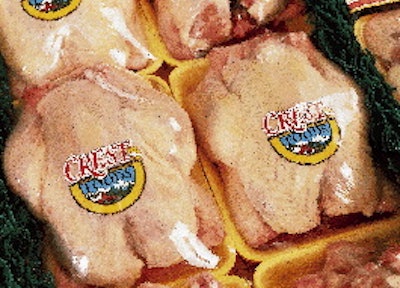Food safety initiatives are falling on Washington like leaves around the Capitol in the fall. Whether meat, poultry or fruit, domestic or foreign, everything is suddenly suspect. You can almost hear cries of "Remember Hudson Foods." So far, no one at the USDA has said that meat and poultry packaging standards are on the firing line. But the truth is that for the past year or so, before Hudson Foods became hamburger, the Food Safety and Inspection Service (FSIS) had started to look much more closely at the packaging used for chicken patties, turkey, steaks, canned beef stew and every other product under their purview. Suddenly, the FSIS was expecting rigid compliance with Food and Drug Administration laws on food contact products. "They are asking for more information than they did before," acknowledges Norm Bornstein, director of global product safety and regulatory compliance for Cryovac. He says the FSIS requires the packaging vendor to get a formal FDA confirmation that a resin or other packaging component is not reasonably expected to become a component of the food. To comply, the vendor must go through the "threshold of regulation" (TOR) process. Before, the FDA simply reviewed the vendor's analytical data. The new requirement costs the vendor time and money. In case of direct additives, the vendor now has to get a formal FDA confirmation that the material is generally recognized as safe (GRAS). 'Seals of approval' These FDA seals of approval must be included in the guarantee letter which accompanies each packaging material going to a meat or poultry plant. USDA audits these letters. Moreover, Bornstein says, six months ago the FSIS began insisting that those letters also list each additive in the package. John Damare, director of the office of compounds and packaging review at the FSIS, says the new attention to detail stems in part from changes in personnel in his shop and at the FDA. "There are new scientists interpreting the FDA laws more strictly," he explains. Bornstein says he does not blame the FSIS, or the FDA, which is really in the driver's seat. "They are doing what we have asked the FDA to do," he explains. The industry requested more efficient procedures for reviewing the safety of additives in packaging that were below levels of dietary concern. Industry expected neither the new procedures to be so seemingly picayune nor their reverberations to shake the meat and poultry industries. One packaging vendor heavy into shrink wrap says he had to pull a new packaging material off the market when he became concerned that the certification provided to him by a material supplier was inadequate. He declines to detail how many companies were using that packaging, or what their reaction was when he had to pull his product out of their warehouses. The Society of the Plastics Industry has asked the two leading officials at both agencies to, in essence, "call off the dogs." But Damare, the FSIS packaging chief, says he and George Pauli, his FDA counterpart, are unlikely to ease off. Application of those FDA laws starts with inspectors from the FSIS and state agencies who do random packaging audits at about 150 meat, poultry and egg producing plants each year. That annual number is out of a total of about 9ꯠ plants. Some inspectors work directly for the FSIS, others are state employees. Looking for the same thing Both groups look for the same thing: whether the packaging used by the plants-glass jars, aluminum cans, waxed paperboard boxes, shrink wrap, foamed trays, etc.-is in compliance with FDA rules for food contact packaging. Even recipe cards enclosed in the package must meet those rules. In calendar 1995, the most recent year for which the FSIS has statistics, the FSIS was unable to confirm the safety of eight different packaging products used at eight separate meat and poultry plants. The packaging manufacturers were put "on notice" as a result. The FSIS's Damare does not have details on the specifics of those incidents. But he says the kinds of problems that crop up are when an inspector believes that a can manufacturer is using a solvent that has not been cleared by the FDA for food contact use. Or a company can be using plastic packaging for liquid food that incorporates resin that's been approved solely for dry food. In some instances, there can be problems with chemicals used in the processing of the packaging, such as anti-microbials used in pulp processing. In both instances, those chemicals are considered by the FDA to be indirect food additives. For example, the issue of solvents may be especially thorny these days for can manufacturers who are facing a MACT from the Environmental Protection Agency. MACT stands for Maximum Achievable Control Technology. It sets a maximum level of toxic air emissions, a standard that often requires a company to change the solvents it uses in its products. Robert Budwey, president of the Can Manufacturers Institute, states that the EPA was scheduled to issue a "presumptive" MACT in October 1997. That would be the first step toward imposition of final MACT standards, probably in 2002. In some instances, the FSIS may prohibit suspect packaging from being used, which may cause some temporary problems for the meat and poultry packer. In other instances, the packaging supplier may have to rework its formulation. The worst case is when the FSIS puts packaging from a recalcitrant supplier on a "black list," which, according to Damare, has never happened, but almost did earlier this year. The supplier decided to drop the packaging line rather than have it put on a "black list," says Damare, who declines to identify the offending vendor. Particularly irritating to the food packaging community are requests from meat and poultry inspectors for evidence of FDA approval of solvents, catalysts and other production aids, such as anti-microbial chemicals used in pulp processing. The FSIS has insisted that these companies obtain FDA concurrence of their suitability for use in producing food packaging materials. That wouldn't be a big problem if the FDA would issue so-called "nonobjection" letters. But the FDA has instead required companies to file TOR requests, which can make the data about the use of reaction control agents-usually closely guarded trade secrets-publicly available. Aside from the damage done by that disclosure, the packaging supplier has to spend precious time and energy getting that TOR approval.
























